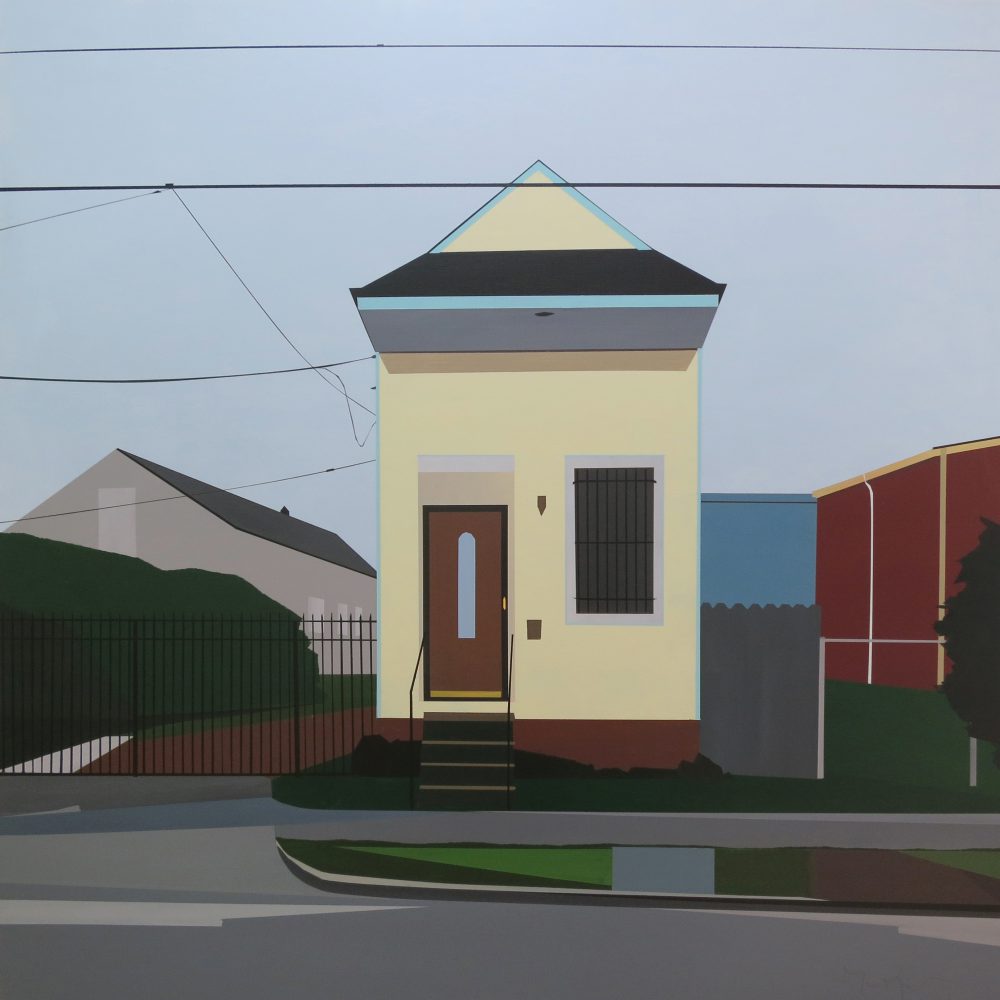Discord in the Ordered: Another Look at Greta Van Campen
Leah Harrington responds to Jacob Kiernan’s review of Greta Van Campen’s recent exhibition at Octavia Art Gallery.

Greta Van Campen, Nearing New Orleans, 2015. Acrylic on panel. Courtesy the artist and Octavia Art Gallery, New Orleans.
Editor's Note
With the large number of exhibitions in New Orleans, we rarely make space for multiple reviews of a single show. But when Big Red & Shiny editor Leah Harrington contacted us via Twitter with a pointed response to Jacob Kiernan’s recent take on Greta Van Campen’s paintings, we embraced the opportunity to publish a direct dialogue between two writers. At Pelican Bomb, our goal has always been to bring artists, writers, and readers together and to offer diverse perspectives on contemporary art in New Orleans. We look forward to your joining the conversation!
Sixty years ago, photographer Robert Frank drove west from New York. His resulting book, The Americans, is a brooding paean to the country at mid-century, each photograph a fragment of life at the margins of the American dream. Fraught but entirely authentic, Frank’s project borrows heavily from Walker Evans’s American Photographs in concept and aesthetic. However, where Evans is straightforward and controlled, Frank is complicated and impulsive. For instance, look at Trolley—New Orleans, 1955, one of Frank’s best-known photographs from his journey. A cinematic snapshot of passengers aboard a segregated streetcar, the photograph’s documentary style captures the angst, ignorance, and complacency of race relations in the 1950s (still all too relevant today).
Some 55 years after Frank’s trip, painter Greta Van Campen undertook a similar cross-country expedition. Starting from her native Maine, Van Campen traveled south and west, painting hard-lined abstracted landscapes along the way. The project resulted in a body of 50 paintings from all 50 states. While her paintings of Maine often exude a sense of sentimentality, many of the works from Greta Paints America portray a less than celebratory vision of the country, the landscape as surrendered to man and machine.
Van Campen’s New Orleans paintings, which present the city in her signature geo-abstract style, were recently on view at Octavia Art Gallery. In his review of these paintings, New Orleans-based Jacob Kiernan suggests that Van Campen’s style is too neat and tidy to portray the city authentically and that her aesthetic too closely borrows from Modern painters such as Charles Sheeler and contemporary ones such as Ed Ruscha: “When imposed upon New Orleans, Van Campen’s approach sterilizes the city, turning it into a deadened vision of itself.”

Greta Van Campen, Maurepas Street, 2015. Acrylic on panel. Courtesy the artist and Octavia Art Gallery, New Orleans.
I don’t disagree that Van Campen borrows closely and heavily from Modernists. However, her relationship to Sheeler and Ruscha is akin to that of Frank to Evans. As David Salle so eloquently explained in his review of this year’s “The Forever Now: Contemporary Painting in an Atemporal World” at the Museum of Modern Art in New York, all contemporary painters borrow from their Modern predecessors. Our critiques of contemporary aesthetics (like Van Campen’s) are necessarily derived from our understanding of Modernism’s failed utopianism. In this context, Van Campen’s borrowed aesthetic implies the shortcomings of modernity. Unlike Kiernan, I don't see this as a deadening or sterilizing “anxiety of influence.” Like Frank’s The Americans, Van Campen’s abstraction appropriates a style in order to suggest an anxiety within the idyllic itself.
For example, in Woldenberg Park, Van Campen has flattened sea and sky into one bright blue body, with a bridge and crane at the horizon line among planes of interlocking azure. A brilliant red container ship glides past, ultimately dwarfed by ocean and atmosphere, giving the painting a sense of tranquility. However, Van Campen’s bright Technicolor palette transfigures realistic elements into intrepid artificiality, eroding the calm into a disquieting view of the natural interrupted by man-made structures of commerce.
Similarly, Nearing New Orleans is a nightscape of open road and distant bright lights that adeptly imbues a bucolic scene with a sense of unease and uncertainty. Where once there was open water, now there is asphalt and electricity, and a dark block of black sky bears down on it all.
Van Campen’s landscapes and skyscapes are neatly ordered, yes, but not so precise as to convey a particular place or its people. That’s not their point. Character is presented here, but only through color and form. People are present through their notable absence, their effects on the world implied. Perhaps this is why Kiernan sees her New Orleans paintings as unrepresentative of the city. And maybe this is true, on the face of it. But beneath these clean surfaces ferments an anxiety of natural beauty eroded by complacency. Looking at these works in context with Modern photographers and painters alike allows us to see past the polish to what Van Campen is really painting.
Editor's Note
“Greta Van Campen” was on view November 7 - December 5, 2015 at Octavia Art Gallery (454 Julia Street) in New Orleans.



